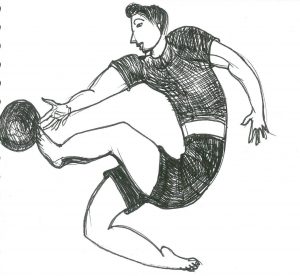(This chapter appeared in the book CREATING CITIZENS: Fr. Ramiro Erviti in Ahmedabad, India. 1956-86. Eds: Howard Spodek, Fr. Chakranarayan, SJ, Vanessa Nazareth-Dalal)
Illustrations by Esther David
Years back, even before, I went to study art at Vadodara’s Faculty of Fine Arts at Maharaja Sayajirao University, I liked to watch our sweeper’s son, who looked after his siblings, while his mother swept the garden. While sweeping, she collected flattened out tooth paste tubes, empty cartons, colourful plastic bags or pieces of scrap, which she gave her son, who fashioned toys out of them to amuse his brothers and sisters. My heart went out to children who could not afford toys, but made their own in clay or other found-objects.
As an art student for the annual art-fair, my Guru Sankho Choudhuri encouraged us to invent new forms with various materials, to help us de-learn some of our education in art.
Later in life, as a practicing sculptor, this formed the base of my work with Outsider Art. I started questioning whether it was possible to be creative without formal education. I felt the spontaneous images of untrained artists were original and intense.
For example, as an only child of working parents, our cook Mani, told me the most fascinating stories. She was a natural story teller. Much later, I was to meet, many more such men and women, who were to strengthen my beliefs in natural artists and intuitive art, because they had no conditioning in art, yet surprised me; with their unusual creations.
So, I did a small art project with Majoor Mahajan Sangh and SEWA in the early seventies. I worked with children from the Devipujak community. The response was enthusiastic and it was fascinating to see the clay toys made by them. Often, their parents helped them to make the forms, but were shy to admit that they; as adults had made toys, although their hand was visible in the clay modeling, so daringly spontaneous.
It was while I was searching for a potter on the riverbed to fire the toys, I met Lavingben, a widow with eight children. She made a living by selling old gunny bags, but her tin shack was decorated with masks of Tiger-heads. During the festivals she sold colourful clay bowls. She had learnt the technique from her grandfather of making a mixture of clay collected from the Sabarmati riverbed, cardboard soaked in water, ashes, powdered crystals of glue and ground fenugreek. After a lot of persuasion she agreed to make masks for me in the same technique that she made clay bowls. She also made, mini boats, small figurines of animals, birds, scorpions, reptiles, fish, crocodiles and Elephant God Ganesha,
An exhibition of these works was organized at an art gallery and Father Erwitti of St. Xaviers Social Service scheme had seen it. The next day, he came to meet me and asked, if I would like to organize women’s activities at the Community Center at newly constructed Sanklit-Nagar for flood-hit hutment dwellers.
I agreed.
On day one, as I opened the window of the office allotted to me and I saw a veiled woman standing there asking me, to find work for her. All I had was paper and paint, so asked her to paint. Slightly raising her veil, she said, “How can I draw, when I cannot write.” I have often heard this term in villages and slum areas.
This was Pushpa Rajaram, from Mathura, who had come to live in Sanklit-Nagar with her handicapped husband and four children. Her husband had lost an arm in an oil-pressing machine in Mathura and they had come to Ahmedabad, looking for work. Her husband sold assorted snacks at the Lal Darwaza bus-stand and had set up home in a tin shack on the Sabarmati riverbed. But, after the floods, they had received alternate accommodation in Sanklit-Nagar.
In our weekly meetings, I discussed Pushpa Rajaram with Father Erviti. He encouraged me to use art for development, make a group of women artists and also help them learn other skills from the tailoring teacher Kalaben, which would lead them towards economic independence and empowerment.
I started work with Pushpa and twenty other women of all communities living in Sanklit-Nagar, which is now known as Juhapura.
Pushpa was a natural artist and worked with me for many years.
Slowly, I gained a greater understanding about untutored art, which led me towards my passion for Outsider Art.
Pushpa is the perfect example to showcase Father Erviti’s vision. She started earning well by transferring her paintings on fabric with appliqué-work. Her designs were used by other women of the group, which was growing, and Father Erviti decided to pay Pushpa an extra amount for her designs. In a few years, she started doing well, became self-sufficient, went to craft workshops, craft-melas, attended adult education class, opened a bank account, took a loan and bought two sewing machines. Eventually, she returned to her village with her family, where she started her own unit of tailoring and patchwork.
Father Erviti commented that through art, she went back to her roots. Pushpa’s forays in the art world had strengthened her; she no longer covered her face, learnt to read, write, sign her name on application forms for loans and was respected in her society as a Mastrani or teacher. With this success story, in a few years, I started a small association to promote Outside Art, which was known as Action through Art.
My interactions with Pushpa, Lavingben and many other women artists, inspired me to write a collection of short stories, which were published by Penguin India, titled By the Sabarmati.
The illustrations in this book are interpretations by the women and their daughters who worked with me at Sanklit Nagar. They depict Father Erewetti’s work, personality and vision, as seen through their eyes…